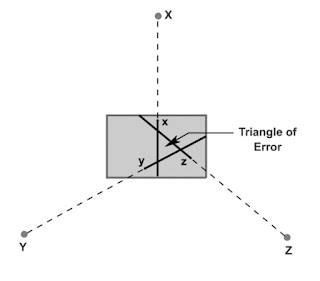METHODS OF PLANE TABLE SURVEY
• Different operations are involved during the location of details through plane table surveying.
• To carry out the operations under different field conditions, different methods of plane table surveying have been evolved –
1. Method of Radiation
2. Method of Intersection
3. Method of Traversing
4. Method of Resect
• The method of radiation and the method of intersection are employed to locate objects and features present in the area of survey.
• The method of traversing is used to plot the network of stations and the method of resection is employed to determine and to plot the location of the plane table as well as to orient the table simultaneously.
1. METHOD OF RADIATION
• In this method, instrument is set up
at a station and rays are drawn to
various stations which are to be
plotted.
• Then distances are cut on a suitable
scale after actual measurement.
• It is suitable for small area where all
the points are visible and accessible
from the station.
• The method is convenient if
telescopic or digital alidade is used.
Otherwise, it is effective when
associated with tacheometer or
EDM for measurement of horizontal
distance.
2. METHOD OF INTERSECTION
• In this method, locating of a point on
the drawing sheet is done by
intersecting two rays drawn from
two different stations.
• Also called as GRAPHICAL
TRIANGULATION.
• It is preferred when distance
between stations is very large and
stations are inaccessible and ground
is undulating
3. METHOD OF TRAVERSING
Let us consider the stations A, B, C and D
Stations are to be chosen in such a way
that adjoining stations are visible
With the alidade pivoted at a, draw the rays
to B and D. Distances AB and AD are
measured and plotted on the respective
rays, ab and ad respectively.
The plane table is then shifted to
station B, get it set and then
oriented by back sighting to
station A.
With the alidade pivoted at b, draw
a ray to C. Distance BC is
measured and plotted on the ray
as bc.
In this way, plane table is shifted to
stations C and D and corresponding
rays are drawn to obtain the plotting
of the traverse abcd.
• This method of plane table surveying is
used to plot a traverse in cases stations
have not been previously plotted by
some other methods.
• In this method, traverse stations are
first selected. The stations are plotted
by method of radiation by taking back
sight on the preceding station and a
fore sight to the following station.
• Here distances are generally measured
by tachometric method and surveying
work has to be performed with great
care.
4. Method of Resection
• It is the process of determining location of station occupied by the
plane table with reference to stations which are already plotted on the drawing sheet
a) Resection by Compass
b) Resection by Backsighting
c) Resection by 3 point problem
• In this method, three well defined points,
having locations already being plotted on
the drawing are involved. These are used to
find and subsequently plot the location of
the plane table station.
• if X, Y and Z are well defined objects
present in the field whose plotted positions
are x, y and z. Now, if the plane table is
oriented correctly, the three resectors Xx, Yy
and Zz get intersected at p which
represents the location of the plane table
station, P on the drawing sheet.
• in three point problem, if the orientation of the plane table is not proper, the
intersection of the resectors through the
three points will not meet at a point but
will form a triangle, known as triangle of
error
• The size of the triangle of error depends
upon the amount of angular error in the
orientation.
• In three point problem, orientation and
resection are accomplished in the same
operation.
• The trial and error method of three point
problem, also known as Lehman's method
minimises the triangle of error to a point
iteratively.
• The iterative operation consist of drawing
of resectors from known points through
their plotted position and the adjustment
of orientation of the plane table.















0 Comments